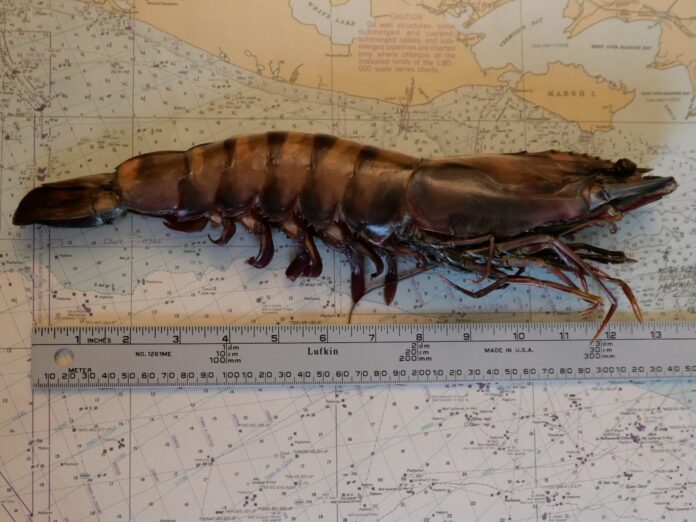HARLINGEN — A voracious, cannibalistic predator that may eventually pose a threat to the $500 million-a-year Texas shrimp industry has turned up in the Brownsville Ship Channel.
A pair of juvenile Asian tiger shrimp about seven inches long were captured in July in two separate nettings in the channel.
Although big-boat shrimpers catch a few Asian tigers off Louisiana and Texas each season, it’s unusual for Asian tiger shrimp to apparently have spawned in waters around South Padre Island.
“The bait shrimpers that fish it pretty much daily caught them in July, two different bait shrimpers,” said Tony Reisinger, a county extension agent for Texas A&M AgriLife Extension Service and Texas Sea Grant at A&M.
“We think they’re siblings,” he added. “I called an expert on them and they said that they were the spawn of 2020 so they were just a few months old, a couple of months old. They were the smallest ones I’ve ever seen. Usually they’re about a foot long.”
Native shrimp in gulf waters reach lengths of eight to 10 inches, and pretty much all of those jumbos are destined for the restaurant industry when they’re caught by one of the 500 or so big shrimp boats which are home-ported in Texas.
Another face of the shrimping industry are the bait shrimpers, near-shore netters like the ones who caught these two Asian tigers, who sell their catch to recreational fishermen.
It isn’t known just how the Asian tiger shrimp reached gulf waters, but theories range from coming in with ballast released by an ocean freighter or, possibly, they are escapees from a Caribbean shrimp farm that were set free by a hurricane in the mid-2000s.
Farm-raising Asian tigers is banned in Texas due to the threat to native shrimp if they escape.
Their voracious tendencies lead them to cannibalize smaller shrimp, like all shrimp do. But the Asian tigers are so big — up to 14 inches and a quarter-pound — that they also take small fish and crabs, and thus pose a potential threat to the food chain in delicate marine ecosystems.
The species also is known to be susceptible to several shrimp viruses, which could spread diseases among native shrimp populations.
“We thought they would compete with native shrimp, perhaps ousting them from their habitat,” Reisinger said. “We didn’t know if they would just increase in numbers quickly, but they haven’t. Our shrimpers catch a few off Louisiana and a few off of Texas every year, but nothing like we thought could happen.”
“But still, that’s really unusual to catch two of them that were more than likely siblings in the Brownsville Ship Channel the same month,” he said. “So that means there’s something going on. We’re just going to carefully watch it and see what happens.”
The Asian tiger shrimp is named for its distinctive stripes, although they can be a variety of colors, ranging from red to yellow and then to black. The light yellow, and stripes, are the most dependable ways to identify an Asian tiger. Those and their immense size.
Reisinger said he’s available if anyone thinks they’ve captured or netted an Asian tiger shrimp to call him at 956-493-8129 for a positive ID.
Just don’t get caught by a Texas Game Warden with a big Asian tiger still flipping around in the cooler.
“One thing they need to do is kill them, they can’t possess them alive or they can get busted,” Reisinger said. “It’s against the law to possess an invasive.”




